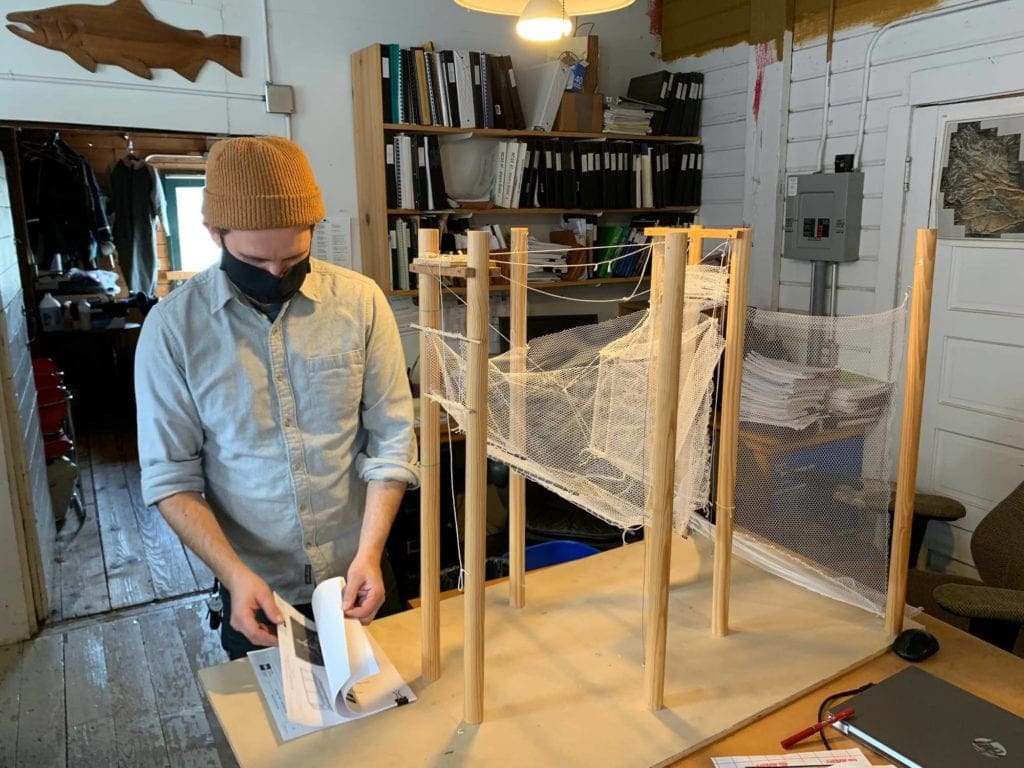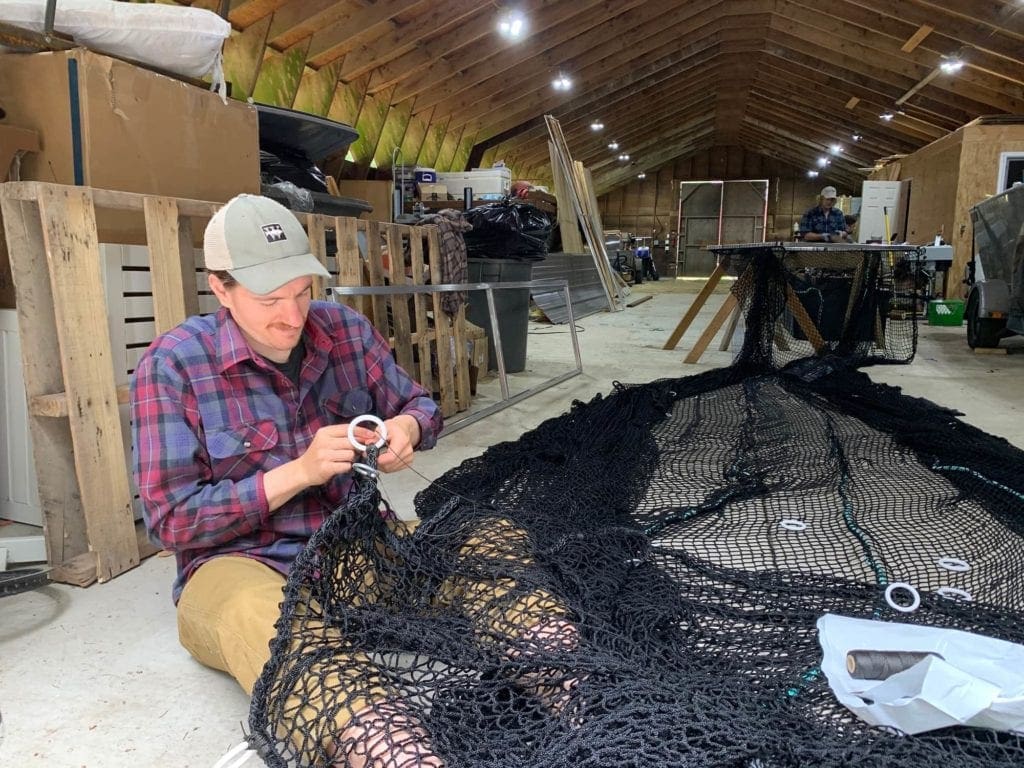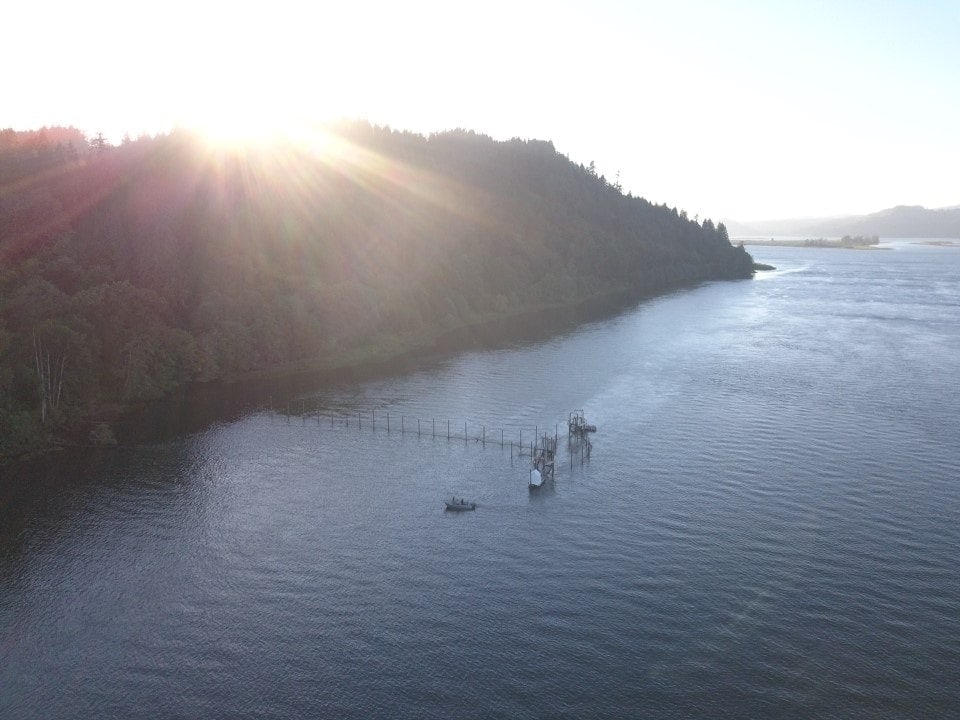We are thrilled to announce that Wild Fish Conservancy (WFC) has installed the first fish trap in the Columbia River, Oregon since 1948. That’s right, it’s been over 73 years since Oregon last had fish traps on the river. Since the mid-20th Century when this fixed-gear was officially banned in the lower-48, a lot has changed. Fish traps that once defined an era of absent management and reckless overharvest now represent the future of sustainable salmon fishing— a low-impact technology for selective harvest of targeted runs and safe release of wild salmon and steelhead bycatch.
While this may be the first you’re hearing about this exciting new project; this historic moment was a massive undertaking years in the making.
Since WFC began work on the fish trap project in the lower Columbia River with our fishing partners in 2016, our staff has carefully observed fish behavior and migration patterns within the prototype and pilot fish trap located near Cathlamet, WA. Over half decade at this project site, we have learned so much from trial and error, continually improving our design year after year.
Now, with this new project in the Columbia River, Oregon, we are applying all of these lessons learned over the last six years into the design of a brand new fully passive fish trap that eliminates air exposure and handling of captured fishes. It is this ‘passive capture’ approach— tested and proven through our peer-reviewed and published pilot research in Washington— that holds potential to nearly eliminate bycatch mortality effects to released wild fishes.

Following the results of our data from 2019 and 2020 that demonstrated the potential of the passive capture approach, our staff has worked to scale-up the passive fish trap design to function on all tides at the new site in Clifton Channel, Oregon. Beginning in 2018-2019, we began modeling this new design for future deployment.
With the passive trapping design modeled and fully engineered by our staff, it took many years to permit and ultimately drive piles for the Oregon fish trap in the fall of 2020. As the first individuals to conduct this kind of work in over 70 years, it was no easy task to work with over seven local, state, and federal agencies to secure approval of our proposed alternative gear research. Although navigating the permitting process took considerable time, the development of alternative gear to allow for safe release of bycatch is a priority of the State of Oregon and Policy of the Oregon Fish and Wildlife Commission; with due diligence, all permits were secured by November 2020.

This past December 2020, we began driving piles that would provide the bones for the new Oregon fish trap, in accordance with the approved in-water work window. This period had its challenges, from busted pile-driving equipment to varied substrate and winter storm conditions. Despite a handful of stressful moments, vibratory driving of the untreated piles was successful, allowing WFC staff to survey the final pile layout and develop our final plans for netting.


WFC worked hard over the winter months conducting surveys of the project site, building live wells and docks, and carefully designing the nets specific to the final piling layout. All engineering, prefabrication, welding— you name it — were done in-house by our talented team of biologists and technicians, who on the side happen to be quite handy when it comes to just about anything.

In the summer, our final net order arrived from Christensen Net Works out of Everson, WA. We continue to be amazed by the quality of work Christensen Net Works performs. Each net was built flawlessly to the inch, as specified in our designs. Our team spent some time adding finishing touches to the nets prior to the on-site installation in August 2021.


In concept, fish traps are extremely straightforward: attach nets to piles or anchors that act as a maze that corral the fish for sorting. However, when you get into the nitty-gritty, it requires a ton of thought and engineering to secure your nets just right to avoid problems with the operation. All WFC staff are certified divers, enabling us to perform some fairly challenging procedures in the field. Ultimately, it’s essentially to ensure the nets are flush to the riverbed to effectively capture fish. In particular, WFC is so lucky to have lead diver and U.S. Marine Veteran Joe Verrelli take charge in the field, allowing deployment to go smoothly.

The trap began taking shape last week as the nets were hung for the very first time. With any new fish trap and design, the first year of installation is always the most challenging, requiring far more time in the field than subsequent years. After the first season, when all of your net attachment points are installed, net deployment time is cut dramatically in the seasons that follow, allowing for deployment and operation of the gear in roughly 5 days.


It’s been a long time in the making, but we are pleased to announce that the fish trap is ready for research operations next week! When the research period begins with falling water temperatures, WFC and our commercial fishing partner Billie Delaney will be making history in operating the first fish trap in Oregon in over 73 years. Our research objectives this season include testing this scaled-up passive trapping design in a new river location, and investigating bycatch encounters and post-release survival of salmon and steelhead. Results may be used by the agencies to inform management and implementation of the recently legalized Emerging Commercial Fishery for alternative gears (i.e., fish traps and seines).

Although this project is occurring in the Columbia River to inform fisheries management in the U.S. Pacific Northwest, this research is serving as a working model to inspire use broadly across fisheries of the West Coast. The work WFC completes in the Columbia River will help management agencies, First Nations, and fishers in other regions make decisions regarding alternative gears and selective fisheries.

Already, our work has helped inspire revitalization of this historical indigenous fishing practice in British Columbia, from the Fraser to the Skeena River. We are hopeful that our research can help guide the transition to in-river selective fishing with low-impact tools like the fish trap in rivers throughout the coast. Growing scientific consensus continues to suggest this transition will be critical to reducing interception of weak stocks in commercial fisheries and allowing for the recovery of threatened wild salmonids and predators such as orca whales that depend on the resource. As we move forward with our research this year, we will be sure to keep you posted on our progress! As usual, its been a roller-coaster ride getting to this point, but we are confident that this will be a pivotal moment for selective fishing with implications far and wide for recovery of wild salmon and coastal communities alike.

Join our mailing list to recieve important updates on our work, the latest wild fish news, & opportunities to take action to support wild fish.
This site is protected by reCAPTCHA and the Google Privacy Policy and Terms of Service apply.
Wild Fish Conservancy is recognized as a 501(c)3 non-profit by the IRS